Multiple Response
Identify one
or more choices that best complete the statement or answer the question.
|
|
|
American Interest in Cuba
By
1825, Spain-once the most powerful colonial nation on earth-had lost host of its overseas possessions
. It retained only the Philippines, the island of Guam, a few outposts in Africa, and Cuba and Puerto
Rico in the Americas . However, the United States had long had an interest in Cuba . In 1854,
diplomats had recommended to President Franklin Pierce that the United States buy Cuba from Spain. In
1860, the Democratic Party's national platform called for the admission of Cuba to the Union.
Toward the end of the century, events in Cuba drew the United States into war with
Spain
| |
|
|
|
1.
|
Which statement is
true
|
|
|
2.
|
Which statement is
true?
|
|
|
CUBAN POLITICAL AND ECONOMIC
INSTABILITY

Cuban Sugar
Plantation
Both
Puerto Rico and Cuba had strong cultural ties with Spain, but Cuba also had a history of rebellion.
From 1868 to 1878, Cubans fought their first war for independence . They forced Spain to abolish
slavery in 1886 but failed to achieve independence .
After the emancipation of Cuba's
slaves, American capitalists rewarded Cuba by investing millions of dollars in large sugar cane
plantations on the island . Cuba:s economy depended on sugar, and the United States now became
Cuba's main market . In 1884, the United States had abolished its tariff on Cuban sugar, causing
sugar production to skyrocket. But when a high tariff on Cuban sugar was restored in 1894, the Cuban
economy was ruined
| |
|
|
|
3.
|
What forced Spain to give up
the practice of slavery in Cuba?
|
|
|
4.
|
When the U.S. removed the
tarrif (tax) on sugar imports, what effect did it have on the production of sugar in
Cuba?
|
|
|
5.
|
CHECK EACH ANSWER THAT IS
TRUE (MORE THAN ONE)
Why
did the 1894 tarrif on Cuban sugar hurt the Cuban economy?
|
|
|
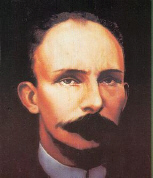
Jose Marti | SECOND WAR FOR INDEPENDENCE
Anti-Spanish sentiment in Cuba soon erupted into a second war for independence . Jose Marti,
a Cuban poet and journalist in exile in New York, launched a revolution in 1895 . He had a great deal
of support from American businessmen and newspaper editors. Martf organized Cuban resistance against
Spain, using an active guerrilla campaign and deliberately destroying property, especially American
owned sugar mills and plantations . Marti counted on provoking U.S. intervention to help the rebels
achieve Cuba Libre!-a free Cuba.
Public
opinion in the United States was split. Many business people wanted the government to support Spain
in order to protect their investments . Other Americans, however, were enthusiastic about the rebel
cause. The cry "Cuba Libre!" was, after all, similar to Patrick Henry's "Give me
liberty or give me deathl" Americans saw the Cuban people as oppressed people and gave them wide
spread support | | |
|
|
|
6.
|
What was the name of the Cuban
patriot who, with the help of Americans, organized the Second War for
Independence.
|
|
|
7.
|
What was the chant used by
Americans and Cubans to protest Spanish domination of Cuba?
|
|
|
The Threat of War Escalates
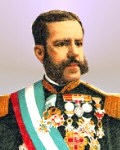
In 1896, Spain responded to the Cuban revolt by sending General Valeriano
Weyler to Cuba to restore order. Believing that regular military methods would not work against
guerrilla tactics-in which small bands of local fighters attack by surprise-Weyler moved the entire
rural population of central and western Cuba into concentration camps . An estimated 300,000
Cubans filled these camps, where thousands of them died from hunger and disease within two
years.
| |
|
|
|
8.
|
Which statements are true?
|
|
|

| YELLOW JOURNALISM
Weyler's actions
fueled a war over newspaper circulation that had developed between the American newspaper tycoons
William Randolph Hearst and Joseph Pulitzer. To lure readers, Hearst's New York
Journal and Pulitzer's New York World printed exaggerated accounts-by reporters such as James
Creelman-of "Butcher" Weyler's brutality. Stories of poisoned wells and of children
being thrown to the sharks deepened American
sympathy for the rebels . Legitimate reports of
Cuban suffering mixed with these sensationalized stories became known as yellow
journalism-reporting that exaggerates the news to lure new readers
Spanish authorities
restricted the freedom of the reporters that Hearst and Pulitzer sent to Cuba and prevented them from
entering combat areas. Some American correspondents claimed to have communicated with Cuban rebels
secretly. Others gathered in Havana's bars and made up reports of battles that never took place.
Hearst sent the artist Frederic Remington, famous for his landscapes of the American West, to Cuba to
illustrate reporters' stories. When Remington informed the publisher that a war between the
United States and Spain seemed unlikely, Hearst reportedly replied, "You furnish the pictures
and I'll furnish the war."
| | |
|
|
|
9.
|
What is yellow
journalism?
|
|
|
10.
|
What effect do you think yellow
journalism had on American attitudes toward the Cubans and the Spanish?
|
|
|
11.
|
When William Randolf Hurst told
the painter, Remington, "You furnish the pictures and I'll
furnish the war." what did he mean?
|
|
|
THE DE
LOME LETTER
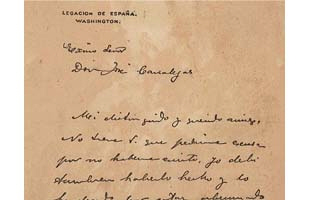
Many
Americans sympathized with the Cuban rebels. When President William McKinley took office in 1897,
demands for American intervention in Cuba were increasing. Preferring to avoid war with Spain,
McKinley tried diplomatic means to resolve the crisis. At first, his efforts appeared to succeed.
Spain recalled General Weyler, modified the policy regarding concentration camps, and offered Cuba
limited self-government .
In February 1898, however, the New York journal published a private
letter written by Enrique Dupuy de Lome, the Spanish minister to the United States . A Cuban rebel
had stolen the letter from a Havana post office and leaked it to the newspaper, which was thirsty for
scandal . The de Lome letter criticized President McKinley, calling him "weak" and "a
bidder for the admiration of the crowd."
De Lome's judgment of McKinley was actually
much milder than Theodore Roosevelt's . Roosevelt, assistant secretary of the navy, considered
McKinley "a white-livered cur" with "no more backbone than a chocolate eclair!"
Although some Americans agreed with de Lome's opinion of McKinley, they resented this criticism
of their president by a Spanish official. Before an indignant State Department could demand his
recall, de Lome resigned
| |
|
|
|
12.
|
Which statements below are
true?
|
|
|
13.
|
What was the De Lome letter
about?
|
|
|
14.
|
Why were Americans angry about
the De Lome letter?
|
|
|
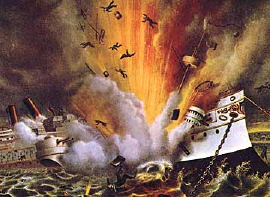
Only a few days after publication of the de Lome
letter, American resentment toward Spain turned to outrage . Early in 1898, President McKinley had
ordered the U.S.S. Maine to Cuba to protect American lives and property. The Maine was an American
battleship. |
On February 15, 1898, an explosion sent the ship's ammunition up in flames,
and the Maine sank. More than 260 of the 350 American officers and crew aboard lost their
lives.
No one really knows what caused
the explosion that destroyed the Maine At the time, a naval court of inquiry reported that the ship
had hit a mine, while a 1976 study by Admiral Hyman G. Rickover determined that an internal explosion
in the ship's coal bunkers had caused the initial blast. In 1898, however, the yellow
journalists held Spain responsible . The Journal's headline read "THE WARSHIP MAINE WAS
SPLIT IN TWO BY AN ENEMY'S SECRET INFERNAL. MACHINE." Hearst's paper offered a reward
of $50,000 for the capture of the Spaniards who supposedly had committed the
outrage
| | |
|
|
|
15.
|
Why was the Maine sent to sit
in Havana harbor?
|
|
|
16.
|
What happened to the
Maine?
|
|
|
17.
|
What did American yellow
journalists do about the Maine?
|
|
|
18.
|
Who was responsible for the
fate of the Maine?
|
|
|
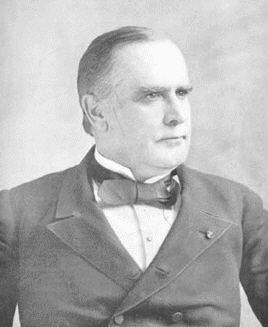
President William McKinley
|
War Breaks Out
Now there
was no holding back the forces that wanted war. "Remember the Maine ."became the rallying
cry for U.S . intervention in Cuba. It made no difference that the Spanish govern- ment agreed, on
April 9, to almost everything the United States demanded, including a six-month
cease-fire.
Despite the Spanish
concessions, public opinion favored war On April 11, McKinley asked Congress for authority to use
force against Spain in order to bring peace to Cuba. After a week of debate, Congress agreed, and on
April 20 the United States went to war with Spain.
| | |
|
|
|
19.
|
Which statements are true?
|
|
|
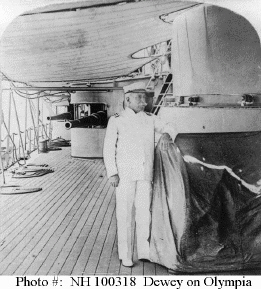
Admiral George Dewey on
Battleship Olympia | THE PHILIPPINES
Although American attention
focused on Cuba, the first battle of the war took place on the other side of the world-in the
Philippine Islands . In February 1898, Roosevelt had ordered the Pacific fleet to sail for the
Philippines in case war with Spain broke out . A Spanish colony for over 300 years, the Philippines
had repeatedly rebelled against Spanish rule.
On May 1, George Dewey, the American naval
commander in the Pacific, steamed into Manila Bay and then destroyed the Spanish fleet nearby. Spain
lost 381 men, while the United States lost only one sailor, who collapsed from the heat .
Dewey's victory allowed U.S. troops to land in the Philippines . Over the next two months,
11,000 Americans joined forces with Filipino rebels led by Emilio Aguinaldo. In August,
Spanish troops in Manila surrendered to Americans rather than to the Filipinos, who had been fighting
for freedom since 1896
| | |
|
|
|
20.
|
Where was the first battle of
the Spanish American war fought?
|
|
|
21.
|
What was the name of the
Admiral in charge of the American fleet that fought the Spanish fleet?
|
|
|
22.
|
What was the name of the
Phillipine rebel who joined forces with the Americans to defeat the Spanish
|
|
|
U.S . FORCES INVADE
CUBA
Back in the Caribbean, hostilities began with a naval blockade of Cuba. Admiral
William T. Sampson effectively sealed the Spanish fleet up in the harbor of Santiago de Cuba.
Meanwhile, American troops organized to invade the island
Dewey's victory had demonstrated the superiority of
U.S. naval forces . In contrast, the U.S. Army maintained only a small professional force,
supplemented by a larger inexperienced and ill-prepared volunteer force. About 125,000 Americans had
volunteered to fight. However, the new soldiers were sent to training camps that lacked adequate
supplies and effective leaders. Moreover, there were not enough modern guns to go around, and the
troops were outfitted with heavy woolen uniforms that were unsuitable for Cuba's tropical
climate. In addition, the officers most of whom were Civil War veterans-had a tendency to spend their
time recalling their war experiences rather than training the volunteers
.
| |
|
|
|
23.
|
Which statement is
true?
|
|
|
24.
|
What did America do to prepare
for an invasion of Cuba?
|
|
|
ROUGH
RIDERS
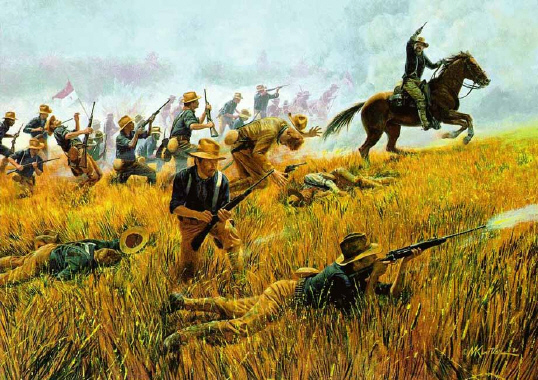
Despite these
handicaps, American forces landed in Cuba in June 1898 and began to converge on the port city of
Santiago. The army of 17,000 included four African-American regiments of the regular army and the
Rough Riders, a volunteer cavalry under the command of Leonard Wood and Theodore
Roosevelt.
The most famous land battle
in Cuba took place near Santiago on July 1 . The first part of the battle, on nearby Kettle Hill,
featured a gallant uphill charge by the Rough Riders and two African-American regiments, the Ninth
and Tenth Cavalries .Next, Roosevelt and his Rough Riders attacked the important, San Juan
hill. American newspapers declared Roosevelt and his Rough Riders the heros of San Juan
Hill.
Two days later, the Spanish fleet tried to escape the American blockade of the harbor at
Santiago . The naval battle that followed, along the Cuban coast, ended in the destruction of the
Spanish fleet . On July 17, Santiago surrendered, and on July 25, American troops invaded Puerto
Rico.
| |
|
|
|
25.
|
Who was the hero of San Juan
hill in Santago, Cuba
|
|
|
26.
|
Where was the Spanish fleet in
Cuba finally destroyed?
|
|
|
TREATY OF PARIS OF 1898
The
United States and Spain signed an armistice on August 12, ending what Secretary of State John Hay
called "a splendid little war." The fighting had lasted only 16 weeks. Of the approximately
300,000 Americans who had served in the armed forces, about 5,400 lost their lives. Of this number,
379 were battle casualties, while the rest died from diseases or other causes .
On December
10, 1898, the United States and Spain agreed in a treaty that (1) Cuba would become independent, (2)
Spain would give Puerto Rico and the Pacific island of Guam to the United States, and (3) the United
States would pay Spain $20 million for the annexation of the Philippine Islands
.
| |
|
|
|
27.
|
What were the results of the
Spanish American war? Check all
that apply
|
|
|
28.
|
When did the Spanish American
war end?
|
|
|
29.
|
What was the major cause of
death of the 5,400 Americans who died in the war?
|
|
|
ANNEXATION OF THE
PHILIPPINES
The Treaty of Paris touched off great debate in the United States . Arguments
centered on the annexation of the Philippines, but imperialism was the real issue. President McKinley
told a group of Methodist ministers that he had prayed for guidance on Philippine annexation and had
concluded "that there was nothing left for us to do but to take them all [the Philippine
Islands], and to educate the Filipinos, and uplift and Christianize them." McKinley's
imperialist beliefs must have clouded his memory-most Filipinos had been Christian for centuries
.
Other prominent Americans presented a
variety of arguments-political, moral, and self-serving-against annexation . Some felt that the
treaty violated the Declaration of Independence by denying self-government to the newly acquired
territories . The African-American educator Booker T. Washington argued that the United States
should settle race-related issues at home before taking on social problems elsewhere . The labor
leader Samuel Gompers feared that Filipino immigrants would compete for American
jobs.
On February 6, 1899, the
annexation question was settled with the Senate's approval of the Treaty of Paris. The United
States now had an empire.
| |
|
|
|
30.
|
Whih statements are true? Check all that
apply.
|
|
|
31.
|
On February 6, 1899, the Senate
approval of the Treaty of Paris and the Phillipines was annexed. The United States now had an empire.
|